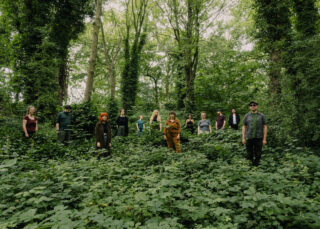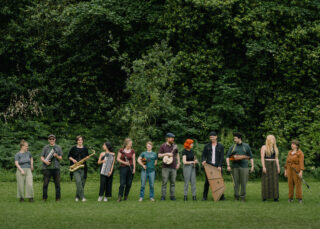DIY improv group Emergence Collective: “This is a micro-scene in its own right”
The opposite of gatekeeping

The opposite of gatekeeping
“Improvisation is a term that really puts people off and can be intimidating,” says Rob Bentall, who plays the nyckelharpa, a Swedish key harp, in Emergence Collective. “We strive to be the opposite of that. We want to be an accessible forum where people can come, improvise and know they won’t be judged on what they do.”
With a pool of around 30 musicians from Sheffield and the surrounding areas, Emergence Collective are an experimental post-minimalist outfit who make music that is improvised, yet alluringly accessible. Once a month they get together in the upstairs room of the Gardeners Rest, a community pub next to the River Don. Structured much like an old-school folk club, people turn up with their instruments, and over foamy cask ale they jam together with whoever is there – be it six, eight, twelve or more people. However, rather than blast out old standards, familiars and favourites, they always create entirely new and improvisational works.
“The background of everybody is very diverse,” says guitarist Tim Knowles. “We have classically trained musicians, folk musicians, composers, jazz musicians, pop musicians. It’s one of those situations where if you were to write it down on paper it probably wouldn’t come together in the way it has. We’ve been consistently surprised.”
The collective has been performing a variety of improvised gigs too. The result of one such performance makes up the contents of their latest album, Fly Tower (released via new Sheffield label Redundant Span), a live recording captured inside the fly tower of Abbeydale Picture House, a former cinema dating back to 1920. It was recorded in a four-storey-high room behind the main theatre, which was historically used to hoist scenery for the productions inside.
“When we choose venues to play in, we want to hear that venue,” says Knowles. “There’s a reason that we’ve named this album after the venue because we feel the venue was a defining feature of that sound and of the way that we chose to perform in that space.”
Over three tracks, the album unfurls in beautiful patterns, filled with a degree of subtlety, tenderness, restraint and a cohesion that belies its improvisational foundations. In this instance, ten members of the collective performed on the recording, all sat in a circle facing one another – a set-up intended to be the antithesis of a traditional band structure.
“When we play live, it’s a really non-hierarchical process,” says Zebedee Budworth, who plays the hammer dulcimer. “There are no leaders, the only thing that’s predetermined is the key that we play in and that’s due to the limitations of my instrument. We just pick a key and then off we go.”
Flutes intermingle with gently plucked strings, toots of baritone sax float above ripples of percussion, while dreamy vocals coalesce with the distinct and engulfing tones of the hammer dulcimer and the nyckelharpa. It’s remarkably measured and considered music given it is being birthed in real time.
“Whatever the group decides, whatever narrative we decide to spin together, and patterns we play, that’s what happens,” says Budworth. “It’s really lovely. If you had a group of musicians where ten people were all wailing and totally shredding all the time, it would probably be the worst thing in the world – or maybe the best – but we occupy quite a nice space within more experimental approaches to music, in the fact that it’s quite listenable.”
“It adds a spontaneity to a performance which you wouldn’t get if it was planned,” says Juliana Day, who contributes recorders, whistles and vocals. “It creates a really special energy to it – people have cried at our gigs.”
Some of the members almost have too. “When I’m playing I feel as if I’m a member of the audience,” says Budworth. “This project is a really important way to break down the barrier between the musicians and the audience. Because I’m watching people play these things for the first time it can really catch you off-guard. One gig, a few months ago, there was a moment where Gemma, one of the singers, did this vocal and it totally caught me off-guard. I was nearly moved to tears by the music that I was playing that I’d never heard before, and that I was watching and hearing for the first time. That is absolutely amazing.”

The collective has also become “like a music community,” says Bentall. “Like a micro-scene in its own right.” Day echoes this. “It’s really building a scene in Sheffield for this kind of music,” she says. “And bringing lots of different people together. We did a workshop recently for people to play and get involved in and one of the bits of feedback was that what we were doing was the opposite of gatekeeping – that was really nice.”
So, are there no rules whatsoever to this group? Is it a total free-for-all? “I like things quiet,” says Budworth. “That’s kind of the only thing that I’d say [is a rule]. I don’t like playing with PAs because we’ve got these amazing instruments that are pieces of work that have been handcrafted. To hear the natural sound of them is really, really important.” Bentall adds: “There’s a lot of magic in an ensemble that’s fundamentally quiet and having the listener coming to the music, rather than the music being pushed to you.”
Budworth makes comparisons to Low. “They just used to turn down if anyone was talking in the audience,” he says. “That’s what we’re doing; we’re basically saying that you need to come to us, you need to listen with us. You need to experience this as part of the people in the room.” Knowles suggests that this approach is “quite novel in an overly technologised musical world.”
While it has successfully managed to operate as a creative and community hub for the people of Sheffield, there are plans to widen the collective even further. “One of the things that we’re quite excited about this project is the possibility of touring it,” says Knowles. “And including different musicians when we go to different locations.”
“Yeah, we’re gonna franchise it and make loads of money,” Budworth adds with a laugh.
Joking aside, there is a genuine sense of shared enthusiasm about just how far Emergence Collective, and its underpinning egalitarian ethos, can go. “It welcomes more experimental and out-there thinking in terms of approaches,” says Budworth. “It’s really like a play box that once it’s opened can have so many different possibilities.”